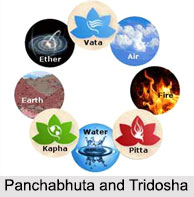 Doshas in Ayurveda is one of the most significant components of the human psychology. It is considered that this particular aspect of the body is really of vital importance as it is responsible for coordinating and directing all the substances and structures of the body.
Doshas in Ayurveda is one of the most significant components of the human psychology. It is considered that this particular aspect of the body is really of vital importance as it is responsible for coordinating and directing all the substances and structures of the body.
Functions of Doshas in Ayurveda
In order to understand the proper functioning of the doshas, their complete knowledge is required. It is stated in Ayurveda that the functioning of the doshas actually helps in understanding the intelligence that commands the dhatus and malas of the body. These two are the other two most important components defined in Ayurveda. Doshas also gives the body the required vast functional capability.
Theory of Doshas in Ayurveda
The theory of the doshas is considered as the crown jewel of Ayurvedic science. It is also defined as the cornerstone of all the diagnostic and treatment modalities. This is a very powerful conceptual tool and by using this tool, the Ayurvedic physicians can detect and treat patients at the earliest stages of the disease process. In fact, it is also said that through the Doshic Model, any physician can locate the seeds of the disease long before their clinical symptoms appear. The doshic system can make sense of the early symptoms and complaints of any health problem and point to some effective treatments.
 In the Ayurvedic texts, it is clearly stated that neither in fact nor in any theory, is there any physical manifestation that cannot be accounted for by the concept of "Tridosha system in Ayurveda". The Ayurvedic texts also confirm that by properly handling this one specific aspect that is dosha, everything gets handled automatically. It is mentioned that just like the theory of Panchabhuta in Ayurveda, the three dosha theory is a bit complicated and it demands a more intuitive approach to study the body. Like the dhatus and malas in Ayurveda, the doshas have no clear material qualities. In case of the mahabhutas, Ayurveda relies on observation and comparison to understand their functioning within the body.
In the Ayurvedic texts, it is clearly stated that neither in fact nor in any theory, is there any physical manifestation that cannot be accounted for by the concept of "Tridosha system in Ayurveda". The Ayurvedic texts also confirm that by properly handling this one specific aspect that is dosha, everything gets handled automatically. It is mentioned that just like the theory of Panchabhuta in Ayurveda, the three dosha theory is a bit complicated and it demands a more intuitive approach to study the body. Like the dhatus and malas in Ayurveda, the doshas have no clear material qualities. In case of the mahabhutas, Ayurveda relies on observation and comparison to understand their functioning within the body.
Relationship between Doshas and Bhutas
It is believed that what goes on in the world at large also goes on within the human psychology. The organising principles of each of the five elements give a proper understanding of their nature. It also gives a practical insight into the dynamics that drive all the bodily processes. The basic difference is that when the elements manifest within the body, they are called as the Doshas. All the five elements of the universe are responsible for orchestrating creation, yet some of the elements play an active role as compared to others. Akash and Prithvi are the first and the last element that are static and are unchanging in nature. The three remaining elements of Vayu, Agni and Jala are active and it is in the dynamic nature of these three elements that the capacity for change and the process in nature resides. Prithvi also changes under the influence of these three elements. The elements of Vayu and Akash combine to become "Vata", the first of three doshas. Agni in combination with some of the qualities of Vayu and Jala becomes "Pitta", one of the three doshas. And lastly, jala supported by prithvi becomes "Kapha", the third one of the Tridosha. The three doshas have a particular taste associated with them. For instance, vata is pungent, pitta is sour and kapha is sweet.
Doshas in Ayurveda have a great impact and it actually provides the body, its normal functional capabilities.




















